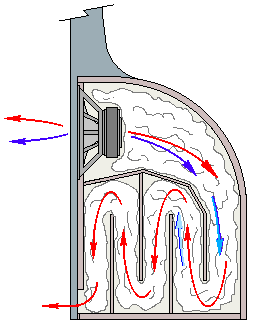What is a Transmission Line (T/L) enclosure? Why use them? To answer these questions, it will be helpful to understand the problems caused by conventional closed box or vented enclosures as are used in most other speaker systems. Closed box enclosures (also known as sealed, infinite baffle, or acoustic suspension enclosures) ruin the transient response of the woofer, fail to support the deep bass, and add extraneous vibrations that "color" the sound.
The transient response is ruined because the woofer compresses the air in the box as it is driven into the enclosure. The compressed air acts like a spring and it forcibly pushes the woofer back out of the enclosure when the musical signal reverses phase or the music stops. The woofer cone needs to stop when it gets to its neutral position to accurately follow the music and have good transient response. The relatively high mass of the woofer cone has a lot of inertia and it tends to sail far past ("overshoot") the desired stop point. As if the woofer’s mass wasn't trouble enough, the compressed air in the box also pushes the woofer past the stop point. The result is a great deal of “overshoot and ringing." This ringing causes the bass to sound muddy, slow, and ponderous.
Woofers have essentially no bass output below their fundamental resonance frequency. A closed box has a relatively high resonant frequency so fails to support the deep bass. To try to improve the deep bass, designers tend to use very massive cones with soft suspensions to try to lower the fundamental resonance. Although this does make it possible for the system to have deeper bass, the increased mass degrades the transient response even more.
Vented enclosures are deliberately designed to have strong resonances to help support the deep bass. Although this does give more output to a very limited range of bass frequencies, the response is highly non-linear and unnatural sounding. Also, resonance is the opposite of transient response. For good transient response, you want ZERO resonance.
The radiation from the back of the woofer is just as intense as that from the front. This rear energy is directed into the enclosure - but what happens to it? Most of this energy is dissipated forcing the walls of the enclosure to flex and vibrate. This causes unwanted sound to come from the enclosure sides, "coloring” the sound. Energy that is not dissipated in the enclosure is radiated back through the woofer cone, again causing sounds to be heard that are not part of the music.

A Transmission Line solves all these problems. A T/L is essentially a long, tapered tube with the woofer mounted in one end. The tube is filled with a soft, absorbent “damping material" much like pillow stuffing. Obviously a long straight tube would be impractical in your living room, so T/Ls are best rectangular in shape and "folded" into a more or less conventional box.
A T/L causes the woofer to have good transient response because it “damps" the woofer’s motion. Unlike a closed box, the woofer cannot compress the air in a T/L because the air can “leak" out the end of the line. When the woofer moves back toward its neutral spot, instead of compressed air pushing it beyond that point, the woofer has to "suck" air back into the line. This causes the woofer to stop instead of flying past its neutral point.
Most of the rear energy of the woofer (BLUE arrows) is absorbed in the damping material by being converted to heat as it pushes its way through the millions of fibers in the line. Therefore there are virtually no unwanted sounds coming from the enclosure sides or back through the woofer cone.
The T/L cannot stop the very long wave-lengths of low frequency sound (RED arrows). These very low frequencies escape from the end of the line. However, the damping material will have slowed these waves considerably, and between that and the long length of the line, these frequencies will be significantly delayed before being released from the enclosure. The result is that the low frequencies come out in-phase with the front radiation of the woofer. When they are in -phase, they support the deep bass - and they do so over a very broad frequency range. This is why T/Ls are noted for having such excellent deep bass. Finally, all enclosures have resonances that color the sound. Properly tapering transmission lines will ensure that instead of having two or three large resonances like conventional enclosures, the T/L will have an infinite number of very tiny resonance's that are completely absorbed by the damping material. The result is an enclosure that is resonance-free.
The bass from a properly built T/L is utterly clean, has excellent deep bass extension, no overshoot or ringing, no resonances, and superb transient response. It is no surprise that the transmission line woofer system blends perfectly with an electrostatic element.
T/Ls normally are large, complex, and expensive to build. They are still difficult and expensive to build, but there is no other way to build a flawless hybrid electrostatic system.
